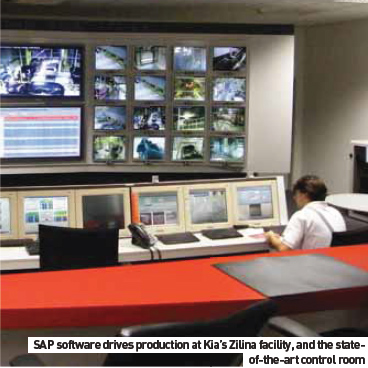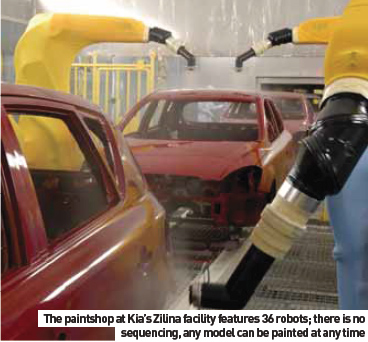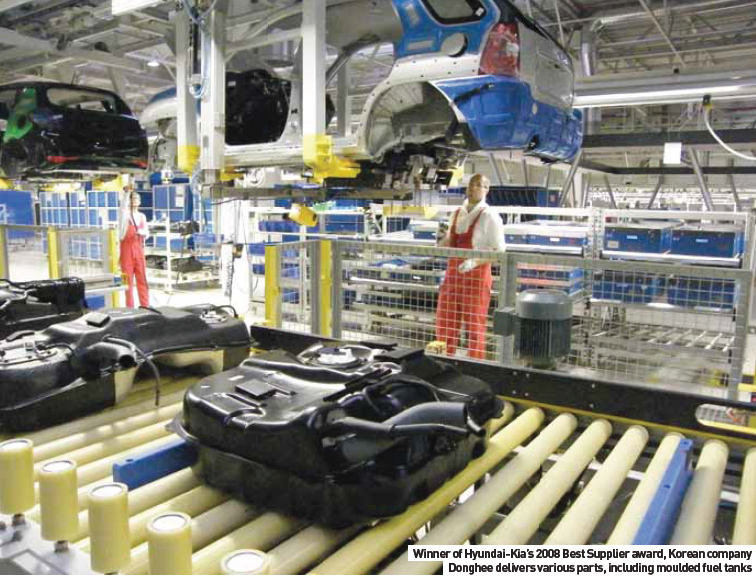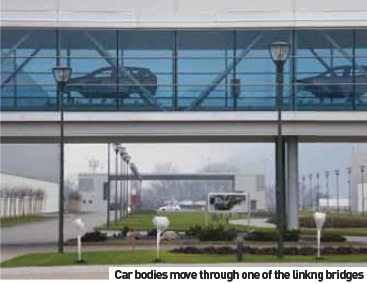
Technologies put in place at Kia Motors Slovakia seem to back up the claim that it is the company’s – and perhaps the world’s – most efficient automotive production plant.
In Kyu Bae, President and CEO of Kia Motors Slovakia, says that the company’s latest plant, located in Zilina, is the most flexible, most efficient plant that Kia currently operates. It is, he adds, perhaps the most efficient plant in the world.
In measuring plant efficiency, Bae can draw on a wealth of company experience, having been with Hyundai - and then Kia - since 1977. Starting in the engineering division of Hyundai Mobis (Production), he further completed assignments in Mexico, South Korea and ultimately at the Hyundai facility in Montgomery, Alabama, before taking control in Slovakia.
“This plant is much better (than Hyundai Alabama), in terms of automation and the software. Productivity and the quality of labour is very high,” he says.
 In reference to automation, the Zilina plant has 413 robots installed throughout the plant – a ratio of one machine for every seven employees. Largely supplied by ABB and Hyundai Heavy Industries, the bodyshop features 198 spotand CO2-welding robots, 12 sealing robots, and a further 110 used in material handling throughout the press and body shop. Further examples demonstrating the depth of automation can be seen in the use of Dürr AGVs, delivering complete underbody structures (with full powertrain and suspension) to the marriage stations in final assembly, while glass (front and rear) is applied without human intervention. SAP supplies the mentioned software, which controls virtually every aspect of plant production, including manufacturing execution systems and finance. The system also allows access to real-time production data, a feature that Bae believes ultimately delivers an advantage over competing carmakers.
In reference to automation, the Zilina plant has 413 robots installed throughout the plant – a ratio of one machine for every seven employees. Largely supplied by ABB and Hyundai Heavy Industries, the bodyshop features 198 spotand CO2-welding robots, 12 sealing robots, and a further 110 used in material handling throughout the press and body shop. Further examples demonstrating the depth of automation can be seen in the use of Dürr AGVs, delivering complete underbody structures (with full powertrain and suspension) to the marriage stations in final assembly, while glass (front and rear) is applied without human intervention. SAP supplies the mentioned software, which controls virtually every aspect of plant production, including manufacturing execution systems and finance. The system also allows access to real-time production data, a feature that Bae believes ultimately delivers an advantage over competing carmakers.
People power
Despite the density of automation, one of the deciding factors for selecting Slovakia - and Zilina - over sites in Poland and the Czech Republic was the quality of the local labour. Throughout the communist era, the city was renowned as a centre of heavy engineering expertise, while present-day Zilina and nearby Bratislava both offer advanced engineering universities. As for productivity, Bae says that the decision to incorporate such a high degree of automation has effectively future-proofed the facility.
“I’m always asked why we have so much automation in the plant when labour in Slovakia is comparatively inexpensive. My reply is that it is difficult to maintain required consistency using manual labour. We want repeat quality and for that, we have to use robotics. In Slovakia, the price of labour is going up, so the associated costs will be much higher in the future. I want good quality, so even if the initial investment for automation is very high, we are thinking long-term, anticipating labour costs five or ten years from now.”
In managing future manpower expenditures, the capital investment for such depth of automation will likely reap future  dividends. But what of the theory ‘replace a man with a robot and you still need the man to maintain the robot’? “Over the past five years, we’ve trained our people in robot maintenance,” says Bae. “In fact, we’ve trained so many that we now have a course dedicated to robot maintenance. The robot manufacturers have come here from Korea and other locations to give our people specialized training, so it’s no problem keeping the robots in top condition. Our efficiency is considerably higher due to the use of robotics.” Jan Taliga, Senior Manager (Assembly), offers more on the balance between labour and automation in the Zilina plant. “While the Czech Republic and Slovakia used to have cheap labour in comparison to other Western countries, over the next 10 years we expect wages to increase to match those of our European counterparts. This is why we have invested in automation; it’s for the future. In the bodyshop, we only have about 95 employees per shift. In the press shop there are only about 45 people and in the paintshop, about 190 per shift. All three areas are highly automated.”
dividends. But what of the theory ‘replace a man with a robot and you still need the man to maintain the robot’? “Over the past five years, we’ve trained our people in robot maintenance,” says Bae. “In fact, we’ve trained so many that we now have a course dedicated to robot maintenance. The robot manufacturers have come here from Korea and other locations to give our people specialized training, so it’s no problem keeping the robots in top condition. Our efficiency is considerably higher due to the use of robotics.” Jan Taliga, Senior Manager (Assembly), offers more on the balance between labour and automation in the Zilina plant. “While the Czech Republic and Slovakia used to have cheap labour in comparison to other Western countries, over the next 10 years we expect wages to increase to match those of our European counterparts. This is why we have invested in automation; it’s for the future. In the bodyshop, we only have about 95 employees per shift. In the press shop there are only about 45 people and in the paintshop, about 190 per shift. All three areas are highly automated.”
In total, says Taliga, Kia Zilina has approximately 2,800 employees. Assembly takes place over two shifts, five days per week, while engine production is spread over three shifts and the same number of days. Total production in 2010 is 210,000 (maximum capacity is 300,000), while the facility also produces 300,000 engines per year. “If you compare the number of cars produced by the number of employees to other facilities,” says Taliga, “we are one of the top automotive manufacturers.” At full capacity, the production goal is 100 cars per employee per year.
Logistics and weather
Zilina is well-placed geographically for delivery of parts and modules, while the central European location also serves to reduce transit times for finished vehicles. The plant itself is on the main route to Bratislava and Vienna, while there is also a rail link on site. With the decision made to build the Kia plant in Slovakia, Taliga reports that 12 Tier One suppliers followed the company into the region; the supplier base created around Zilina was a contributing factor in Hyundai’s decision to build its latest European plant in Nošovice, Czech Republic, only 85km to the north-west. Kia, though, has experienced problems with the delivery of local infrastructure improvements. “The new highway from Bratislava to Zilina should have been completed in 2006, but it is still under construction,” says Taliga. “We had some concerns about this, as many of our suppliers are based near Trencín (located between Zilina and Bratislava). They chose those locations on the understanding that the highway would be finished. We are now hoping that the highway will be completed this summer.”
Dies used in the panel presses at Kia Motors Slovakia are supplied from Korea. But before being delivered to Kia’s facility in Zilina, each is sent to Germany for a special coating treatment developed by Oerlikon Balzers, part of the Switzerland-based Oerlikon Group. Where forming tools used in panel presses are normally hardened using a chromium plating, Oerlikon Balzers has developed a hardening process it calls ‘Pulsed Plasma Diffusion’. According to In Kyu Bae, President and CEO of Kia Slovakia, the process offers four major advantages over standard hard chromium plating. First, where traditional dies require recoating every six months (on average), tools treated using the PPD process can last the full life of a given model. Second, the technology eliminates the problem of particles embedding into the hard chromium plating, which if not removed would cause defects in the fi nished panels. Third, the treated panels allow increased press speeds. Where Kia was producing 400 parts per hour with chrome-plated dies, it can produce 500 using dies treated using PPD. The fourth advantage is that unlike hard chromium, the PPD process is non-toxic and environmentally friendly. Having been fi rst used at Kia Slovakia, Oerlikon Balzers’ Pulsed Plasma Diffusion process is set to become the benchmark for panel press tooling Changing dies at Kia Slovakia used at all Hyundai/Kia’s global production sites.
 When asked if the company feels let down by the failure to complete the highway on schedule, Taliga replies that the company is very happy with the support received from the government. Pressed further, he admits it would be better if the highway was already finished, though failure to deliver the roadway had not had any influence on production capacity.
When asked if the company feels let down by the failure to complete the highway on schedule, Taliga replies that the company is very happy with the support received from the government. Pressed further, he admits it would be better if the highway was already finished, though failure to deliver the roadway had not had any influence on production capacity.
The winter weather in Zilina is also a concern, with poor conditions possibly affecting part deliveries. Taliga: “There is a Korean Tier One company that built its factory in Ostrava, Czech Republic, they are supplying some body parts. The road (to the plant) is not a highway. If there was a problem, that could influence our production in Zilina, as we have very little storage at the factory.” In addition to this, the Kia plant supplies engines to the Hyundai factory, an arrangement that could also be affected by bad weather, but Taliga says there have not been any problems to date. The Zilina plant is itself designed to minimize the impact of winter conditions, where temperatures can drop to –30oC. The four workshops are constructed in a square layout and connected by a series of bridges. Parts and car bodies are conveyored between the press, body, paint and assembly halls – a monorail system moves large panels from the bodyshop - and at no point do vehicles come in contact with outside air. Further to this, the engine plant delivers finished product to the plant via an overground tunnel.
It is anticipated that the same delivery method will be used when a second engine production facility at the Zilina plant enters production. With construction scheduled to start in April, the new engine plant will have a limited output. “The building will offer sufficient area for production of a further 300,000 engines per year, but the initial investment will be for an output of 150,000 units,” explains In Kyu Bae. “This will come on line in 2011 and if market conditions improve, we’ll look for more orders.” He goes on to say that while a percentage of output will be directed to Nošovice, a portion will also be shipped to Hyundai’s new plant in St. Petersburg, Russia, due to enter operation in 2011.
World-class flexibility
While engine production is a large part of Zilina, the core competency remains vehicle production and In Kyu Bae is  looking forward to expanding the plant’s model range. “This year we will start production of two new models, the nextgeneration Sportage, production of which will start in June 2010, and the Hyundai ix35 SUV. We’ve invested in new jigs, fixtures, robots, some other system and equipment changes in preparation for production.” While skilled labour and depth of automation contribute to Zilina’s claim to being the most efficient Kia plant, it is the plant’s production flexibility that draws a line under it possibly being the most efficient automotive manufacturing plant in the world.
looking forward to expanding the plant’s model range. “This year we will start production of two new models, the nextgeneration Sportage, production of which will start in June 2010, and the Hyundai ix35 SUV. We’ve invested in new jigs, fixtures, robots, some other system and equipment changes in preparation for production.” While skilled labour and depth of automation contribute to Zilina’s claim to being the most efficient Kia plant, it is the plant’s production flexibility that draws a line under it possibly being the most efficient automotive manufacturing plant in the world.
“We will be producing three different Cee’d models (hatchback, estate and three-door Procee’d), the Sportage and the ix35,” says Jan Taliga. “That’s five, but the line can handle up to eight different bodies. There’s only one assembly line for all these models. We’re doing this and we still have some future capacity.” He goes on to point out that production at the plant is simply based on orders; there is no blocking and no sequencing on the line. “There are very few plants where a C-segment car is built on the same line as an SUV, but ours is one of them.” The same ‘one line’ policy runs throughout the plant, with only a few exceptions. For example, while the paintshop has two lines fitted with ABB robots, any model can enter either line – and there is no batching in terms of colour. Says Taliga: “In the paintshop, we can paint any car any colour at any time, it’s very flexible.”
The engine shop is set up using the same philosophy. There are four lines, for preparation of head, crankshaft and two bodies (diesel and petrol), but there is only one assembly line for all engines. Taliga says all jigs and tools are available on the line for any engine. The engine shop is located adjacent to Mobis, Kia’s largest single supplier, which is responsible for completing powertrain assembly and lineside delivery.
Part delivery
In 2009, Slovakia switched from the Slovak crown to the euro. The move, says Jan Taliga, has benefitted Kia as most supply contracts were negotiated in euros. While he goes on to say there was no great difference in overall contract value, adoption of the single currency has created stability in pricing. The change has been of particular importance when dealing with companies outside Slovakia, which include Saint-Gobain, delivering glass from its Polish facility. Taliga points out that a series of suppliers have set up facilities next to or in close proximity to the Zilina facility; for him, a preferable arrangement to a longer supply chain. Wheels and tires are pre-assembled by Glovis, with aluminium wheels sourced from China and steel wheels from the Czech Republic. Johnson Controls has also set up a production facility in Zilina, delivering seats and headliners to Kia – and other manufacturers in the region. As there is virtually no inventory held at the plant, parts are delivered just-in-time and just-in-sequence to the assembly line from trucks fitted with conveyors that match those within the plant.

ground up
Kia Motors Slovakia has earned a number of awards for its environmental work, including the International Certifi cate of Environment Management (ISO 14001), and certifi cation as an environmentallyfriendly facility in February 2008. Cars produced at the plant have also claimed their share of environmental awards, with the Cee’d being the fi rst Korean model to win the DFE (ISO 14062) and LCA (ISO 14040), given respectively in acknowledgment of the car’s recyclability and lifetime environmental impact. Examples of a commitment to maintaining the interior and exterior environment can be seen across Kia’s Zilina production facility. In the assembly hall, a new under-fl oor extraction system removes harmful emissions from the fi nal testing area, preferable to a roof-mounted system which in drawing air upwards, still allows noxious fumes to circulate. In the paintshop, a low-energy regenerative thermal oxidizer is used to eliminate hydrocarbons and odours created in the drying process. Additional steps were also taken to preserve the environmental integrity of the area surrounding the plant. Before construction of the paintshop, the site was layered in special soils designed to prevent the possible spread of contaminants, while waste water from the production process is treated at the plant before being returned to the local sewerage system. In a favourable trade-off, Kia’s water usage at Zilina has recently increased, though only to enable a dramatic reduction in the use of solvents at the plant.
Despite the success in setting up a local supply chain, In Kyu Bae says that the euro is still too high in value. “We’ve localized 70% of parts in western Europe and Slovakia, with the other 30% coming from overseas. We can do this because with the high value of the euro, Korean, American or Chinese parts are still cheaper, even with the logistics.” Part quality is also an issue affecting production in Zilina. Bae: “In Korea, they have the manpower and equipment in place to deliver finished parts. If we buy parts elsewhere, the cost is increased through the need for additional manpower and tools to rework the parts. While European part quality can be good, Korean part quality is excellent.” Bae is also in favour of further modulisation, both in terms of part delivery and plant set up. For example, Mobis currently delivers kitted instrument panels to the assembly line and according to Bae, the company could do more of the same for other components. “Mobis has the capability. They have invested in a plant here and they can increase production.”
In terms of plant set up, Bae sees modulsation as offering further production flexibility: “I would like the concept expanded to the plant, where we could have a modular paintshop, a modular body shop, where if we need additional capacity, we could expand the plant to produce the required numbers.”
Working with labour
Kia Motors Slovakia has not managed to escape being affected by the downturn across European markets. Bae, though, was committed to not cutting the plant’s workforce. “At the start of the crisis, in 2008, we saw our competitors were cutting staff. We had to make a decision; do the same, or find another solution. I didn’t want to cut labour, but we needed to survive.” Bae and his team in Zilina settled on a plan that involved cutting working hours instead of jobs, switching from two eight-hour shifts per working day to two six-hour shifts, with no cuts in manpower.
At the same time, a cost-cutting drive was implemented across the plant covering materials and energy usage. While production over 2009 fell by 25%, Bae notes the company made considerable reductions in gas and electricity usage. “We’re looking to increase our volumes this year, but the energy savings will remain in place. This way, we hope to improve our overall bottom line.”
Asked if he has time to visit the production line, Bae replies: “I visit the lines every day, sometimes several times. Every day, at 4:30pm, I have meetings with quality managers, production managers, to talk about issues surrounding production.” It’s just another part of maintaining the plant’s position as the most efficient Kia facility in operation today. While it’s verging on the impossible to identify any single production facility as the world’s best, it certainly has to rank as one of the most efficient plants currently in operation.


































